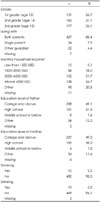Abstract
Objectives
Cyberbullying has recently become a major concern in Korea and especially poses a serious threat to adolescents. The object of this study is to examine the psychopathology of perpetrators and victims of cyberbullying.
Methods
In a cross-sectional study, 490 middle school students completed questionnaires on bullying and victimization experiences in cyberspace. Korean-Youth Self Report (K-YSR) was included to evaluate the psychopathology of the students.
Results
The prevalence rates of victims and perpetrators of cyberbullying were 6.92% and 3.33%, respectively. Among 9 sub-scales of K-YSR, the scores of depressed/anxious (p=0.049), thought problems (p=0.002), and attention problems (p=0.039) were significantly different between victim, perpetrator, victim/perpetrator, and control group. Multinomial logistic regression indicated that the victim group was associated with depressed/anxious [odds ratio (OR)=1.10], social immaturity (OR=1.24), thought problems (OR=1.32), and self-destructive identity problems (OR=1.16). The perpetrator group was associated with thought problems (OR=1.37) and attention problems (OR=1.21). The victim/perpetrator group was associated with delinquent behavior (OR=2.04).
Conclusion
Middle school students involved in cyberbullying were associated with psychopathologies including depression, anxiety, thought problems, attention problems, and delinquent behaviors. The risk of cyberbullying is escalating with the rapid advancement in technology. Therefore, a comprehensive approach should be employed for prediction and prevention of cyberbullying in adolescents.
Figures and Tables
References
1. Sontag LM, Clemans KH, Graber JA, Lyndon ST. Traditional and cyber aggressors and victims: a comparison of psychosocial characteristics. J Youth Adolesc. 2011; 40:392–404.

2. Hinduja S, Patchin JW. Cyberbullying: neither an epidemic nor a rarity. Eur J Dev Psychol. 2012; 9:539–543.

3. Erentaitė R, Bergman LR, Zukauskienė R. Cross-contextual stability of bullying victimization: a person-oriented analysis of cyber and traditional bullying experiences among adolescents. Scand J Psychol. 2012; 53:181–190.

5. Juvonen J, Gross EF. Extending the school grounds?--Bullying experiences in cyberspace. J Sch Health. 2008; 78:496–505.

6. Riebel J, Jaeger RS, Fischer UC. Cyberbullying in Germany-an exploration of prevalence, overlapping with real life bullying and coping strategies. Psychol Sci Q. 2009; 51:298–314.
7. Tokunaga RS. Following you home from school: a critical review and synthesis of research on cyberbullying victimization. Comput Human Behav. 2010; 26:277–287.

8. Beran T, Li Q. Cyber-harassment: a study of a new method for an old behavior. J Educ Comput Res. 2005; 32:265–277.

9. Sticca F, Perren S. Is cyberbullying worse than traditional bullying? Examining the differential roles of medium, publicity, and anonymity for the perceived severity of bullying. J Youth Adolesc. 2013; 42:739–750.

10. Agatston PW, Kowalski R, Limber S. Students' perspectives on cyber bullying. J Adolesc Health. 2007; 41:6 Suppl 1. S59–S60.

11. Bonanno RA, Hymel S. Cyber bullying and internalizing difficulties: above and beyond the impact of traditional forms of bullying. J Youth Adolesc. 2013; 42:685–697.

12. Olenik-Shemesh D, Heiman T, Eden S. Cyberbullying victimisation in adolescence: relationships with loneliness and depressive mood. Emot Behav Diffic. 2012; 17:361–374.

13. Perren S, Dooley J, Shaw T, Cross D. Bullying in school and cyberspace: associations with depressive symptoms in Swiss and Australian adolescents. Child Adolesc Psychiatry Ment Health. 2010; 4:28.

14. Wang J, Nansel TR, Iannotti RJ. Cyber and traditional bullying: differential association with depression. J Adolesc Health. 2011; 48:415–417.

15. Hinduja S, Patchin JW. Bullying, cyberbullying, and suicide. Arch Suicide Res. 2010; 14:206–221.

16. Messias E, Kindrick K, Castro J. School bullying, cyberbullying, or both: correlates of teen suicidality in the 2011 CDC Youth Risk Behavior Survey. Compr Psychiatry. 2014; 55:1063–1068.

17. Yen CF, Chou WJ, Liu TL, Ko CH, Yang P, Hu HF. Cyberbullying among male adolescents with attention-deficit/hyperactivity disorder: prevalence, correlates, and association with poor mental health status. Res Dev Disabil. 2014; 35:3543–3553.

18. Lee CH, Sung YS, Jung NW, Jang SA, Park SY, Lee JY. A Study on the SNS Use of Young People. Report No.:12-R05. Seoul: National Youth Policy Institute;2012.
19. Oh SH. Policy implications of the cyber bullying: a comparative analysis on the cases and policies between Korea and the United States [dissertation]. Seoul: Hanyang University;2014.
20. Achenbach TM, Edelbrock CS. Manual for the child behavior checklist and revised child behavior profile. Burlington: Department of Psychiatry of the University of Vermont;1983.
21. Oh KJ, Ha EH, Lee HL, Hong KE. Korean-Youth Self Report. Seoul: Huno Consulting Human & Innovation;2007.
22. Balding J. Young people in 2004: the health related behaviour questionnaire results for 40,439 young people between the ages of 10 and 15. Exeter: Schools Health Education Unit;2005.
23. Vandebosch H, Van Cleemput K. Cyberbullying among youngsters: profiles of bullies and victims. New Media Soc. 2009; 11:1349–1371.

24. Hemphill SA, Heerde JA. Adolescent predictors of young adult cyberbullying perpetration and victimization among Australian youth. J Adolesc Health. 2014; 55:580–587.

25. Kim EY, Im SI. The recognition of the youth about the symptoms of smartphone overuse. Korean J Youth Stud. 2014; 21:255–279.
26. Jeon JS, Ko YS, Uhm NR. Internet addiction survey 2012. Report No.: NIA IV-RER-12082. Seoul: National Information Society Agency;2012.
27. Yoon SY, Kwon JY, Choi SG, Jun IS. 2012 Report on national student mental health screening. Seoul: Ministry of Education, Science and Technology;2013.
28. Cho YO. The impact of cyber bullying victim experience and the influence of mediating effect of depression on delinquent behaviors. Korean J Youth Stud. 2013; 20:117–142.
29. Barlett C, Coyne SM. A meta-analysis of sex differences in cyber-bullying behavior: the moderating role of age. Aggress Behav. 2014; 40:474–488.

30. Ybarra ML. Linkages between depressive symptomatology and Internet harassment among young regular Internet users. Cyberpsychol Behav. 2004; 7:247–257.

31. Patchin JW, Hinduja S. Cyberbullying and self-esteem. J Sch Health. 2010; 80:614–621; quiz 622-624.

32. Gradinger P, Strohmeier D, Spiel C. Traditional bullying and cyberbullying: identification of risk groups for adjustment problems. Z Psychol. 2009; 217:205–213.
33. van Geel M, Vedder P, Tanilon J. Relationship between peer victimization, cyberbullying, and suicide in children and adolescents: a meta-analysis. JAMA Pediatr. 2014; 168:435–442.





 PDF
PDF ePub
ePub Citation
Citation Print
Print






 XML Download
XML Download